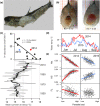The strength and form of natural selection on transcript abundance in the wild
- PMID: 33219570
- PMCID: PMC8246785
- DOI: 10.1111/mec.15743
The strength and form of natural selection on transcript abundance in the wild
Abstract
Gene transcription variation is known to contribute to disease susceptibility and adaptation, but we currently know very little about how contemporary natural selection shapes transcript abundance. Here, we propose a novel analytical framework to quantify the strength and form of ongoing natural selection at the transcriptome level in a wild vertebrate. We estimated selection on transcript abundance in a cohort of a wild salmonid fish (Salmo trutta) affected by an extracellular myxozoan parasite (Tetracapsuloides bryosalmonae) through mark-recapture field sampling and the integration of RNA-sequencing with classical regression-based selection analysis. We show, based on fin transcriptomes of the host, that infection by the parasite and subsequent host survival is linked to upregulation of mitotic cell cycle process. We also detect a widespread signal of disruptive selection on transcripts linked to host immune defence, host-pathogen interactions, cellular repair and maintenance. Our results provide insights into how selection can be measured at the transcriptome level to dissect the molecular mechanisms of contemporary evolution driven by climate change and emerging anthropogenic threats. We anticipate that the approach described here will enable critical information on the molecular processes and targets of natural selection to be obtained in real time.
Keywords: climate change; contemporary natural selection; gene expression; host-parasite relationships; selection differential and gradient.
© 2020 The Authors. Molecular Ecology published by John Wiley & Sons Ltd.
Figures





Comment in
-
Innovative mark-recapture experiment shows patterns of selection on transcript abundance in the wild.Mol Ecol. 2021 Jun;30(12):2707-2709. doi: 10.1111/mec.15946. Epub 2021 May 24. Mol Ecol. 2021. PMID: 33960037
References
-
- Arnold, S. J. (1983). Morphology, performance and fitness. American Zoologist, 23(2), 347–361. 10.1093/icb/23.2.347 - DOI
-
- Baumgart, M. , Priebe, S. , Groth, M. , Hartmann, N. , Menzel, U. , Pandolfini, L. , Koch, P. , Felder, M. , Ristow, M. , Englert, C. , Guthke, R. , Platzer, M. , & Cellerino, A. (2016). Longitudinal RNA‐seq analysis of vertebrate aging identifies mitochondrial complex I as a small‐molecule‐sensitive modifier of lifespan. Cell Systems, 2(2), 122–132. 10.1016/J.CELS.2016.01.014 - DOI - PubMed
Publication types
MeSH terms
Associated data
LinkOut - more resources
Full Text Sources
Medical

